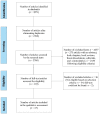Best Practices for Notification of Unexpected, Violent, and Traumatic Death: A Scoping Review
- PMID: 37444070
- PMCID: PMC10341669
- DOI: 10.3390/ijerph20136222
Best Practices for Notification of Unexpected, Violent, and Traumatic Death: A Scoping Review
Abstract
Background: Death reporting is a delicate task. The ways in which it is carried out can have a significant impact on both the recipient and the notifier, especially in the event of a sudden, violent, and traumatic death. Empathetic, sensitive, and attentive communication with survivors can represent a first opportunity to support the bereavement process. The acquisition of specific skills for the delivery of the death notification is necessary for the professional who carries out the communication to increase self-efficacy, knowledge, and perception of competence in this area.
Objective: To map what the literature has produced on the theme of best practices for the notification of unexpected, violent, and traumatic deaths and to provide guidance for the formulation of appropriate best practices and the development of effective educational programs.
Methods: A review was conducted using the PRISMA Scoping Review extension on English language literature published between 1966 and 2022.
Results: Starting from the initial 3781 titles, 67 articles were selected. From a thematic point of view, the analysis of the contents made it possible to identify five dimensions: (1) general guidelines in relation to various professional figures; (2) specific protocols; (3) guidelines for notifying death to children; (4) guidelines for notification of death by telephone; and (5) recommendations and suggestions for death notification training programs.
Discussion: Death notification is configured as a process, divided into sequential phases. The act of notification constitutes the central phase during which communication is carried out. The communication of death is context-specific; therefore, it should require the creation of specific protocols for the various professions involved in the task, along with targeted theoretical and practical training.
Conclusions: The importance of defining specific guidelines for the various professionals and standardized programs of theoretical and practical training emerges. The implementation of future sectoral studies will allow evaluations of the effectiveness of these protocols and programs.
Keywords: best practices; death notification; general guidelines; notifying children; professional figures; telephone notification; training programs.
Conflict of interest statement
The authors declare no conflict of interest.
Figures






References
-
- Parris R.J. Initial management of bereaved relatives following trauma. Trauma. 2011;14:139–155. doi: 10.1177/1460408611420352. - DOI
-
- McGill G., Wilson-Menzfeld G., Moreland M., Kiernan M.D. “Knock on the Door”—Exploration of Casualty Notification and the Long-Term Impact on Military Families in the UK. J. Loss Trauma. 2022;27:547–564. doi: 10.1080/15325024.2021.2009264. - DOI
Publication types
MeSH terms
LinkOut - more resources
Full Text Sources
Medical

